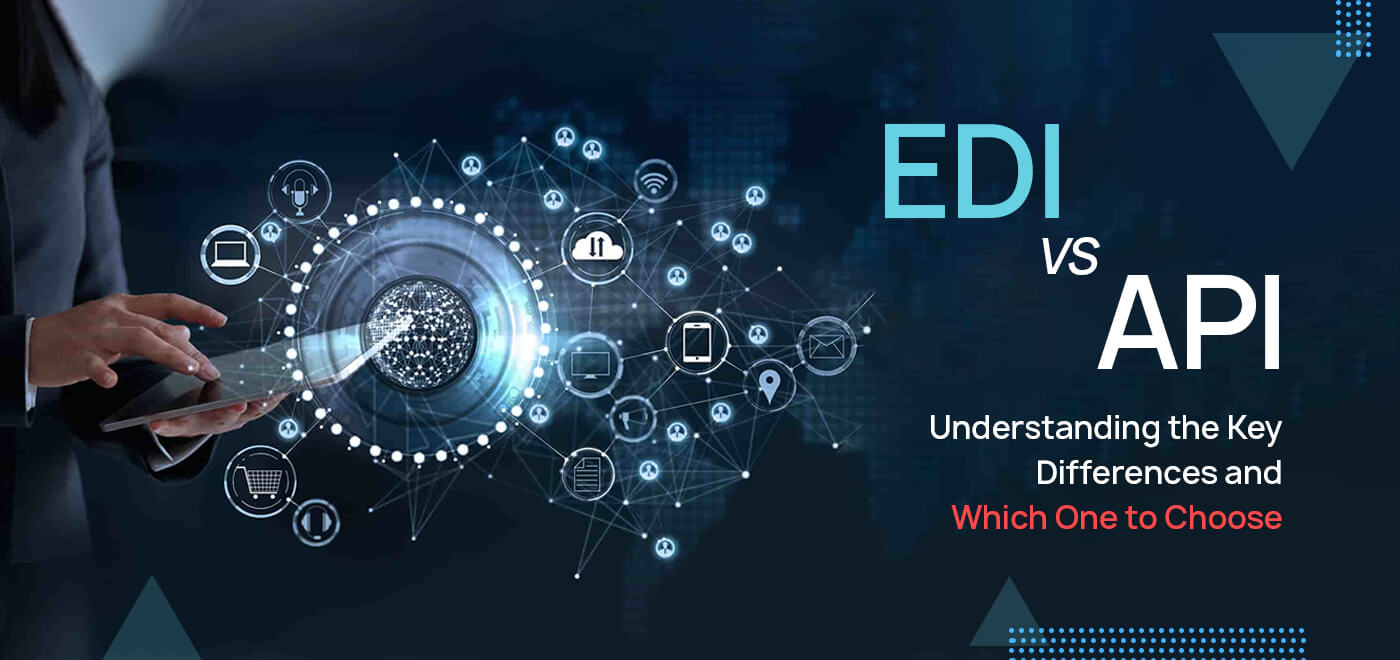Today’s business world spins on the axis of data exchange. It’s like an active web of roads where information zips from one spot to another. This keeps the global economy, our “network,” buzzing with life. Businesses are like towns in this network, relying on these roads not just for their operations but also for their survival.
This “road network” of information exchange is made up of different methods, all important in their own way. Two big names shine in this group: Electronic Data Interchange (EDI) and Application Programming Interface (API). These two are the main pillars of our digital economy today. They help in safe and smooth data transfer. But what are EDI and API? How do they work? And what makes them different? When should a business pick one over the other?
Importance of Data Transfer in Businesses Today
Let’s start with the basics. In our world, that’s growing more digital every day; data isn’t just a trendy term. It’s the fuel for decision-making and strategy, for growth and profits, for making customers happy, and for keeping businesses strong. Think of it like a heart that pumps blood to every part of a body, helping all organs work well. For a business, having a safe and smooth data transfer is as crucial as a healthy heart is for a living creature.
That’s where EDI and API come in. Both are methods of data transfer that many industries use, from logistics and retail to healthcare and manufacturing. Their role in boosting the speed, accuracy, and efficiency of data exchange can’t be praised enough.
EDI services let businesses interchange documents and data with their trade partners electronically in a standard format. Imagine a company that has hundreds or even thousands of transactions every day. Instead of dealing with each transaction by hand, which takes time and can lead to mistakes, the company can lean on EDI service providers. These providers make sure transactions are smooth, automated, and mistake-free. This lets the company focus more on its main business activities.
What is EDI (Electronic Data Interchange)?
Think of EDI as a universal language for business data sharing. It’s like an interpreter at an international meet, ensuring everyone gets the message. Simply put, EDI is a common format that lets firms digitally interchange documents and data. It’s more than just sending and receiving data. EDI ensures the receiver can read and use the data, regardless of their own systems or software.
EDI services, due to their global reach and smooth data sharing, have become precious in today’s business world. Firms of all sizes and sectors use EDI. It helps them run their operations better, cut down on errors, and promote a fluid business setting.
How EDI Works in Business Processes?
To really value EDI, let’s envision a typical business situation. Let’s say a retail firm needs to order goods from a provider. Instead of drafting a purchase order by hand, the retailer can use EDI to make and send this document digitally. The provider receiving this order can interpret it easily, courtesy of the standard EDI format. The outcome? A fast, effective, and automated transaction process that saves time and cuts down on mistakes.
EDI’s role goes beyond purchase orders. It aids in the transfer of various documents, from invoices and shipment alerts to inventory updates. In all these cases, EDI Outsourcing Companies offer a helping hand. They provide their skills and technology to handle EDI processes. This allows businesses to pay more attention to their main operations while leaving EDI management to the experts.
What is API (Application Programming Interface)?
Imagine API as a friendly and efficient secretary at a big firm. When you call the office, the secretary answers, directs you to the right person, or gives the needed info. In a similar way, an API receives your software request. It tells the system what you want and then brings back the response.
Simply put, an API is a set of rules for creating and using software apps. APIs let different software systems communicate with each other, even if they’re written in different programming languages. This ability to connect different software systems makes API important for EDI services and digital data sharing.
How API Functions in the Digital World?
API works as a connecting bridge in the digital world. It links software apps and lets them work together smoothly. For example, when booking a flight online, APIs work behind the scenes. They connect with various systems – the airline’s database, your bank, and your email. They help complete the booking, process the payment, and send a confirmation to your inbox.
APIs are important for EDI services, especially for businesses needing real-time data sharing. APIs help many EDI companies in the USA. They enable quick shipment tracking, real-time inventory updates, and fast document transmission. This ability to share instant data is why APIs are essential in our digital economy.
Key Features of EDI Services
EDI shine in the data exchange field due to their unique traits. EDI’s main power comes from using a common language or format. This allows different systems to ‘communicate’ with each other, breaking language barriers. This makes data exchange faster and easier, reducing manual work and mistakes.
Another crucial trait of EDI is automation. It helps companies to run their regular tasks, like sending out purchase orders or bills, automatically. This saves time and boosts the work rate. The ability of EDI to scale up is also key, allowing companies to manage more data as they grow.
The safety and accuracy of data are also big benefits of EDI services. Sending data electronically cuts down the risk of data loss or changes. The use of codes and other safety steps also keeps sensitive data safe.
Standard Formats in EDI
A main feature of EDI is the use of common formats. These are like languages that both sender and receiver systems understand. Some of the most used EDI standards are ANSI X12 (common in the USA), EDIFACT (liked in Europe), and TRADACOMS (used in the UK retail sector).
These common formats ensure that companies can communicate effectively through EDI no matter what internal systems companies use. For example, a company using an old inventory management system can still send purchase orders to a supplier using a modern ERP system due to EDI. This ability to work together, helped by EDI solutions, is a big reason why the technology is so widely used and effective.
Key Features of API
APIs are like silent workers in our linked digital age. Working quietly, they bridge gaps between different software and systems. They’re akin to a universal power plug connecting devices to power outlets worldwide.
A key trait of APIs is enabling software to work together. They lay out rules and methods, letting different software chat and exchange data. If you’ve logged into an app using Facebook details or checked weather info on a travel app, APIs made it possible.
APIs also pave the way for efficient automation. They make manual work unnecessary and enhance operational speed. This proves valuable for businesses, similar to the benefits of EDI services, in our fast digital world.
In addition, APIs set the stage for innovation. They permit developers to build upon existing platforms, creating new apps and promoting technological progress.
Different Types of APIs
APIs come in various forms, each suited to particular needs. Examples include Web APIs enabling communication via HTTP, Database APIs for database interaction, and Operating System APIs that serve applications on specific operating systems.
Recognizing these different API types can help businesses pick the right API services, like choosing between the best EDI services or various EDI VAN services.
EDI vs. API: Point-by-Point Comparison
Speed and Efficiency
Over time, EDI has shown great efficiency. These services allow smooth, error-free data exchange between businesses, cutting out manual work. This saves both time and resources. But, traditional EDI can be slow due to its batch-processing ways.
Conversely, APIs are champs at sharing data in real-time. They provide up-to-date accuracy. APIs excel where immediate response is needed, like stock trading apps or live tracking systems.
So, if quick, live data exchange is your need, APIs may be the winner. But for regular, systematized data exchange, EDI services might be the best fit.
Scalability
Scalability is how a system manages a growing workload. Here, both EDI and API show promise, but in unique ways.
EDI systems, especially managed EDI services, can handle large transactions. They have been doing this for years. They manage high data loads with ease in areas like retail or logistics.
APIs, however, are naturally adaptable and flexible. They let you swiftly add or alter services as your business grows or shifts. So, while EDI is great at handling large, regular data flows, APIs offer the flexibility to grow and change fast.
Reliability and Security
For reliability and security, both EDI and API bring lots of benefits. EDI, especially managed EDI, gives a tried and tested B2B data exchange framework with strong security measures.
APIs, too, offer reliable data transfer methods with built-in error control and retry features. For security, APIs use modern protocols like OAuth and SSL for secure data transfer.
So, both EDI services and APIs offer strong reliability and security. But with APIs, security is as good as the protocols.
Ease of Implementation and Maintenance
APIs usually need less initial work when looking at easy use and upkeep. They use modern coding languages and cloud-based platforms. This makes them simple to set up and change.
While mature and stable, EDI can be tricky to implement due to its detailed standards and needs. But choosing managed EDI can simplify this. The service provider handles setup, upkeep, and compliance issues.
When to Choose EDI Services over API?
EDI services are a boon in situations calling for frequent, large data transfers. They bring strength and trust to businesses valuing exactness and time-saving. For example, in retail, businesses lean on EDI for precise order handling, stock control, and invoice creation.
EDI also shines in the shipping and logistics field. Here, EDI is the go-to for sending shipping alerts, bills of lading, and other vital paperwork.
Moreover, EDI, especially EDI cloud services, are a treasure in settings where high uptime and disaster rebound are key. They bring constancy and trust, assuring your business runs smoothly in all situations.
The types of businesses and situations that benefit most from EDI
EDI services fit well with certain businesses and situations. Businesses with set, seasoned processes gain much from EDI’s orderly and standard-focused approach.
Large enterprises, mainly in retail, manufacturing, and logistics, lean on EDI for their wide B2B data-sharing needs. They value the mistake-free, prompt data sharing that EDI enables.
Further, businesses needing to stick to specific industry norms or rules often choose EDI. For instance, the healthcare field demands compliance with certain norms for patient data sharing. EDI can ensure this compliance efficiently.
Businesses with hefty transaction volumes or those aiming to automate their supply chain can also gain from EDI. As we’ve seen, EDI is great at managing large, frequent data transactions.
Lastly, businesses with limited IT resources may favor EDI services, specifically EDI cloud. They don’t demand a big on-site IT setup. These services also let businesses hand over their EDI management to an expert provider, freeing up resources for key business tasks.
When to Choose API over EDI Services?
APIs are experts at enabling real-time data exchange. In scenarios needing a swift and direct response, API becomes your go-to. For example, in the e-commerce industry, APIs facilitate immediate inventory updates, crafting a smooth shopping journey for customers.
In settings demanding dynamic and instant data access, APIs outshine. This is notably true for mobile apps where APIs deliver up-to-the-second data to users.
Additionally, APIs are a top pick for highly customized and adaptable scenarios. They can manage complex, special data requests, making them ideal for tech-savvy companies with specific, non-standard needs.
The types of businesses and situations that gain the most from API
APIs serve a wide range of businesses and situations. New, agile businesses with changing processes might enjoy the flexibility of APIs. They value the real-time, on-demand data access that APIs offer.
Tech-focused companies, like those in the software and the internet sectors, often prefer APIs. They can use the customizability of APIs to shape data exchanges to their unique requirements.
Start-ups and smaller businesses might also find APIs enticing. They may lack the solid B2B relationships that make EDI services appealing and, instead, appreciate the flexibility and easy integration that APIs offer.
Moreover, companies that promote integration with third-party apps and services often lean towards APIs. Those aiming to grow their digital ecosystem will value APIs’ ability to enhance interoperability.
Lastly, companies keen on keeping up with tech progress might favor APIs. They recognize that APIs are the key to many modern innovations, from mobile apps to AI-powered tools.
Conclusion
Our journey has revealed EDI and API as two different but equally vital data-sharing technologies. Each has its uses and benefits.
We’ve found out that EDI services offer a solid and reliable choice. They’re a top pick in mature industries with intricate B2B ties. EDI, with its common formats, promotes easy chat between various systems. It truly excels in mass data transfers and regular transactions.
APIs, in contrast, are the hotshots of the tech world. They’re great for live data interchanges, offer plenty of flexibility, and are key for mobile apps and tailored software. From instant data access to third-party service compatibility, APIs unlock a treasure trove of opportunities for nimble, tech-savvy businesses.
Emphasizing the importance of choosing the right data transfer method for business success
Choosing between EDI and API isn’t just about tech. It’s about matching your data-sharing method with your business aims, daily operations, and plans. Remember, no option is perfect for everyone; just the one that fits your unique needs best.
If you’re a classic business with many B2B links and regular transactions, EDI services may be the one for you. API might be your best match if you’re a high-speed, innovation-focused business looking for instant replies and high customizability.
But what if you see worth in both? That’s where the charm of today’s tech comes in. You don’t have to pick just one. Mixed solutions, blending the strength of EDI with the speed of API, are on the rise.
Now, it’s your turn. Assess your data-sharing needs, look at your options, and make a choice that pushes your business ahead. Don’t hesitate to contact Toporgs, an expert EDI service provider, for help using these technologies for your situation best. Take the plunge and see how the right data transfer method can be a game-changer for your business!
FAQs
EDI, or Electronic Data Interchange, is a set method to move data between various computer systems. It’s vital because it ends the need for paper chats, boosting speed, truth, and effect. Firms using EDI services can smooth their work, reduce errors, and build better, easy partnerships with their team.
API, or Application Programming Interface, is unlike EDI. It gives real-time, when-needed data exchange between software. It’s like a postman that carries requests and tells a system your needs, then brings the answer-back. APIs, unlike EDI, offer more room to adjust and tailor, making them a hot pick for firms wanting digital growth.
While EDI and API both offer scalability, API often wins. APIs can manage real-time, when-needed data exchange, so they’re better at handling growing data needs in fast, changing businesses. But, this doesn’t drop the value of EDI in fields where big, set deals are usual.
EDI is often the top pick for firms with many B2B ties that need to set big data transfers. Fields like retail, logistics, and healthcare, where set, regular deals rule, often find big value in the steadiness and trust that EDI services give.
Yes, API and EDI can work together! Modern firms often use both, tapping into the best of each to make a stronger, more flexible data chat space. For example, they might use EDI for big, set deals and APIs for real-time, custom data asks.






